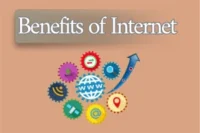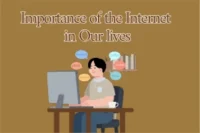History of the Internet: From Dial-Up to the Digital Age
Published: 17 Mar 2025
The modern Internet is a vast, interconnected digital ecosystem that has revolutionized communication, collaboration, and education. Its origins trace back to the 1950s during the Cold War when scientists and military officials sought a resilient communication system. The goal was to ensure continuous communication during disruptions. What started as a government project evolved into the global network we use today, fueled by decades of innovation and technological progress.
This article explores the key moments and figures that have shaped the Internet’s history.
Key Moments in Internet Development
Here are some significant milestones that have shaped the development of the Internet:
- 1969: ARPANET, the first functional packet-switching network, is launched.
- 1971: Ray Tomlinson sends the first email.
- 1983: TCP/IP is adopted as the official protocol for ARPANET.
- 1989-1990: Tim Berners-Lee creates the World Wide Web.
- 1993: Mosaic, the first graphical web browser, is introduced.
- 1998: Google is founded, changing the way search engines work.
- 2007: The iPhone brings mobile Internet access to the masses.
- 2010s: The rise of cloud computing, social media, and streaming services.
Who Invented the Internet? The Journey of Many Innovators
The Internet was not invented by a single person. It was developed over many years by numerous innovators whose combined efforts led to the interconnected world we live in today. Each contribution played a crucial role in shaping the Internet as we know it.
Key Figures and Their Contributions
- Vint Cerf and Bob Kahn: Recognized as “The Fathers of the Internet,” they developed the TCP/IP protocol in 1974, laying the groundwork for data transmission and the architecture of the Internet.
- Tim Berners-Lee: Invented the World Wide Web, making the Internet more accessible and user-friendly.
The Evolution of the Internet: A Decadal Overview
Here is an overview of how the Internet has evolved over the decades, marked by significant technological advancements and milestones.
1960s: Early Beginnings
The Internet began in the 1960s with the creation of ARPANET by the U.S. Department of Defense. ARPANET was the first packet-switching network, allowing computers to communicate over long distances.
1970s: Growth of Networking
In the 1970s, researchers developed communication protocols, including the Transmission Control Protocol (TCP) and Internet Protocol (IP). These protocols are still the foundation of Internet communication today.
1980s: Expansion and the Birth of the Internet
During the 1980s, the Internet expanded beyond military use as universities and research institutions connected to ARPANET. The Domain Name System (DNS) was introduced, making it easier to find websites.
1990s: The World Wide Web
In 1991, Tim Berners-Lee created the World Wide Web, which made the Internet more user-friendly with websites, browsers, and hyperlinks. This marked the rapid growth of the Internet, making it publicly accessible.
2000s: The Internet Becomes Mainstream
In the 2000s, high-speed Internet connections became widely available. Search engines, social media platforms, and online shopping grew, while broadband made it easier for people to stay connected.
2010s: Mobile and Cloud Era
Smartphones and tablets allowed people to access the Internet anywhere. Social media became central to communication, and cloud computing enabled remote data storage and access.
The 2020s: The Internet Today
The Internet is now a fundamental part of daily life, powering everything from smart homes to online education. Innovations like 5G and the Internet of Things (IoT) are shaping the future, connecting more devices and providing faster, smarter solutions. The Internet continues to evolve, influencing how people work, live, and connect globally. Its history is still being written as technology advances.
Conclusion
The history of the Internet is a story of development, starting as a military communication tool and growing into an essential part of daily life. Key moments like the launch of ARPANET, the creation of the World Wide Web, and the rise of Google shaped the Internet we know today. Mobile access and cloud computing further transformed how we connect. As the Internet evolves, it will continue to change the way we live and work.
Discover more about the internet’s evolution, subscribe for insights on technology’s past, present, and future!
FAQs
Here are some frequently asked questions about the history and evolution of the Internet.
The Internet is a global network that connects millions of computers, allowing them to communicate and share information.
A group of researchers developed the Internet. Two key contributors were Vinton Cerf and Robert Kahn, who created the TCP/IP protocols. Tim Berners-Lee invented the World Wide Web.
The Internet became publicly available in the early 1990s after the development of the World Wide Web by Tim Berners-Lee.
ARPANET was the first network to use packet-switching technology and is considered the precursor to the modern Internet.
The World Wide Web (WWW) is a system of websites and hyperlinks that allows users to access information on the Internet easily.
TCP/IP stands for Transmission Control Protocol and Internet Protocol, the fundamental set of rules that govern how data is transmitted on the Internet.
The Internet has transformed communication by enabling instant messaging, video calls, social media, and email, making it easier for people to connect worldwide.
Important milestones include the creation of ARPANET in the 1960s, the development of the World Wide Web in the 1990s, and the rise of mobile Internet in the 2000s.
The future of the Internet will likely include advancements in technologies like 5G, the Internet of Things (IoT), and AI, making the Internet even more integrated into everyday life.
We access the Internet through devices like computers, smartphones, and tablets, which connect to the web using Wi-Fi, broadband, or cellular networks.

- Be Respectful
- Stay Relevant
- Stay Positive
- True Feedback
- Encourage Discussion
- Avoid Spamming
- No Fake News
- Don't Copy-Paste
- No Personal Attacks

- Be Respectful
- Stay Relevant
- Stay Positive
- True Feedback
- Encourage Discussion
- Avoid Spamming
- No Fake News
- Don't Copy-Paste
- No Personal Attacks





